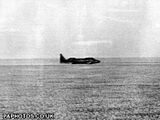|
Campbell was born in 23rd March 1921, Povey Cross, Horley, Surrey, England as the son of Sir Malcolm Campbell. School at Horsham, then St. Peter's School, Seaford then to Uppingham Public School, Rutland. (The same as his father). Following his father's career he strove to set speed records on land and water.
Campbell began speed record attempts using his father's old boat Bluebird K4, but after a 250 km/hr crash destroyed the K4 in 1951 he developed a new boat. The Bluebird II K7 was a jet-propelled hydroplane type with a Metropolitan-Vickers Beryl jet engine producing 4000 lb. of thrust. Campbell set seven world water-speed records between 1955 and 1964. The first was at Lake Ullswater on July 23, 1955, where he set a record of 325 km/hr. The series of increases peaked in December 31, 1964, at Dumbleyung Lake in Australia when he reached 444.6 km/hr.
On land, following a heavy crash at Bonneville with the Bluebird CN7 car in 1960, on July 17, 1964, at Lake Eyre Salt Flats, Australia he set a record of 649 km/hr for jet propelled four-wheeled vehicles (Class A). He became the first person to set both water and land records in the same year. But his land record was short-lived, rule changes meant that Craig Breedlove's Spirit of America soon set new records.
Three years later on January 4, 1967, the re-engined Bluebird K7 flipped and disintegrated at around 450 km/hr on Coniston Water in England killing Campbell. His body was not recovered until May 28, 2001.
Donald and his father had set eleven speed records on water and ten on land between them.
Marriage:
1. 1945 to Daphne Harvey, Caxton Hall Registry Office, London under special Licence as Daphne's parents had forbidden Donald to marry her.
2. To Dorothy McKegg.
3. 24th December 1958 to Tonia Bern, Caxton Hall, Registry Office, London.
Date and Place of Death: 4th January 1967, Died in accident during a speed record attempt in Bluebird on Coniston Water, Cumbria, England whilst exceeding 300 m.p.h.
Age at Death: 45.
Site of Grave: Bluebird boat and body found and retrieved in May 2001. Remains finally buried in St. Andrew’s Church, Coniston, Cumbria, 12th September 2001. Memorial in Coniston, Cumbria, England.
Chronology:
1924: Birth of his sister Jean.
1930's: His first job was as a junior office boy with Alexander Howden and Company, insurance brokers in London.
1939-45: During the period of the Second World War he was turned down as a fighter pilot because of contracting Rheumatic fever when he was younger. Not wanting to join the R.A.F. in a non-flying capacity, he worked for two civilian firms. One making defence equipment for airfields and another making aircraft spares.
1951: Suffered a 170 m.p.h. crash in the boat K4.
1955: 23rd July Ullswater, Cumbria, England. Donald Campbell was the first to complete an officially timed run in a jet-propelled hydroplane (K7) of 202.32 m.p.h.
1960: Crashed in Utah, USA after attempting the land speed record from which he had to spend a long convalescent period.
1964: July 17th: Achieved 403.1 m.p.h. in a jet propelled car at Lake Eyre Salt Flats in Australia. December 31st: Set a water speed record of 276.33 at Durnbleyung Lake in Australia. Thus becoming the only man to achieve land and water speed records in the same year.
1967: (4th January) Achieved a run of 297 m.p.h. on his first leg at Coniston Water, Cumbria and was travelling at over 300 m.p.h. on the return leg when his boat Bluebird flipped over backwards and he crashed to his death. Many theories were advanced as to why he had started too quickly on his return leg but it is clear that the waves on the lake unsettled the boat. Ideas that he had committed suicide were quickly discounted by his family.
(2001): A Diving team from Northumberland finally retrieved Bluebird and later the remains of Donald Campbell so he could be given a proper burial.
Speed Records:
LAND:
July 1964: Lake Eyre, Australia. (403.1 m.p.h.)
WATER:
July 1955: Ullswater, Cumbria. (202.32 m.p.h.)
November 1955: Lake Mead, U.S.A. (216.2 m.p.h.)
September 1956: Coniston Water, Cumbria. (225.63 m.p.h.)
November 1957: Coniston Water, Cumbria. (239.07 m.p.h.)
November 1958: Coniston Water, Cumbria. (248.62 m.p.h.)
May 1959: Coniston Water, Cumbria. (260.33 m.p.h.)
December 1964: Lake Dumbleyung, Australia (276.33 m.p.h.)
Donald Campbell dies in Bluebird crash
Donald Campbell dies during a world water speed record attempt in the Lake District
The funeral of Donald Campbell
Links
|
Donald Campbell's 'Bluebird'
George Negus Tonight ABC2 Transcript
Broadcast 6.30pm on 12/05/2003
Donald Campbell's world land speed record attempt captivated the nation in 1963 and 1964 and this program looks at the historic attempt from three points of view.
George Negus talks to Tonia Bern-Campbell, former crew member and Donald's wife at the time, about her recollections. Next, Elliott Price, manager of Muloorina Station where the record attempt took place, tells his version of the 1963 attempt, and finally, we look back at reporter Frank Bennett's 1964 Four Corners story that captures all the drama on the lake at that time.
GEORGE NEGUS: Tonight, another in our series of special after-the-January-fires reports from Canberra. And for all you speed freaks out there, the fastest of them all - Donald Campbell.
NEWSREEL AND ARCHIVAL FOOTAGE OF RACING CAR: 5,000 horsepower to all four road wheels. The car is ready. The men are ready.
GEORGE NEGUS: The very best of British, as it were, circa 1964. Hi there and welcome to another week of New Dimensions. Tonight, it's back to the early '60s and a period when the Brits actually had a reason other than dropping atomic bombs and launching rockets at Woomera to be in outback South Australia. In fact, it was another vaguely more peaceful technological wonder, Donald Campbell's famous 'Bluebird', that took them there for his assault on the world land speed record. By Sir Donald's side throughout his historic record attempts was his wife, Tonia Bern-Campbell. And almost exactly 40 years later, Tonia joins us, not on the couch as usual, but from California where these days she lives.
TONIA BERN-CAMPBELL: Welcome, Tonia.
GEORGE NEGUS: And welcome to you over here.
GEORGE NEGUS: Tonia, what...why in fact did Donald and the team choose to come to Australia all that time ago?
TONIA BERN-CAMPBELL: Well, because the year before, he crashed in Utah - about two years before. And he then felt it was a sign that he had to keep the record attempt within the Commonwealth. And he always wanted to go to Australia so it was a good...it was two good reasons to go there. Then when he first went, just to meet people, he felt that they were so pro this, they were so for him that it sort of encouraged him even more.
GEORGE NEGUS: What did he have to do to pull the whole thing together? The logistics were quite incredible, weren't they?
TONIA BERN-CAMPBELL: They were, but he had a lot of support from a lot of people, you know. Like, we had support from the government - Sir Thomas Playford was a big help, and, um, so also the prime minister, Menzies, at the time.
GEORGE NEGUS: So everybody was behind the attempt?
TONIA BERN-CAMPBELL: Everybody was behind him, absolutely.
GEORGE NEGUS: All of this happened in...deep in the outback of Australia near Lake Eyre at Muloorina.
TONIA BERN-CAMPBELL: Yes. And, uh, not my favourite holiday resort, I assure you.
GEORGE NEGUS: Muloorina Station, run by the Price family on the edge of Lake Eyre, was Donald and Tonia's base as well as being a working outback sheep property. In fact, the whole Campbell entourage stayed with the Prices while Donald's record attempts took place. Take a look at this marvellous archival footage pulled together for us by our New Dimensions team in Adelaide.
(Old car drives towards makeshift runway)
MAN 1: We treat everybody alike when they come to Muloorina. Out here, the first thing we do is to make them welcome and feel at home. The Campbells fitted in real nice, but they got the same treatment as anybody else. No, you can't afford to waste time on fools in the outback.
(Men get into a large truck)
MAN 2: On April 24, the 'Blitz' was ready to take 'Bluebird' out to the lake. We started alright. Got about a mile from the homestead and the old 'Blitz' just stopped. I felt a hell of a fool when Mr Campbell got an army wrecker to tow us. I'd been blowin' me bags about how good the old girl was.
MAN 1: On account of the breakdown, it was dusk when the 'Blitz' arrived at the lake. Luckily, they were still messing about, putting the finishing touches to the 15-mile-long track, so we weren't the last off the lake. Everything looked real good for the test next day, so we all set off back to Muloorina. But next day, Lake Eyre really was a lake. Half an inch of rain had fallen overnight. It meant that the trial had to be postponed. Well, the 1st of May, everything was ready again for Mr Campbell and his 'Bluebird'. The pressmen and all the people from Muloorina were there to watch as 'Bluebird' was got ready for its first trial run in Australia. We were very proud to have helped in preparing for this moment.
(Campbell prepares to drive)
MAN 1: Actually, the 'Bluebird' started up very sweet and everything went very nice. Though there was a hell of a mirage, it looked to me as if there was no trouble at all as she accelerated away.
('Bluebird' speeds along)
MAN 1: Naturally, the children couldn't talk of anything else. They had to get the flipper out, which I'd made for them earlier. Now it's got an old water-pump engine and an Austin Seven gearbox, and the seats are from an old aeroplane. They set out to break every record they could think of. At this stage, we learned of a far greater threat to the attempt. Floods from the Cooper and Diamantina rivers were sweeping down from Queensland. They were expected to totally flood the lake in under a month's time. Anyhow, this little rain only hung 'em up a few days and then they were off again. All this time the 'Bluebird's speed was being worked up. In my opinion, it looks as if it'd only be a week before Mr Campbell pulled off the attempt.
ELLIOT PRICE, MULOORINA STATION OWNER: (Speaks into radio) Mr Campbell is very anxious to know about the flow of the river down there and how long it's likely to be before it reaches Etadunna and also the Birdsville Track. And back to you, Jim.
JIM ON RADIO: Should hit the Birdsville Track in about four weeks.
MAN 1: The next day after having reached our highest speed so far - 240 miles an hour - made in spite of high winds and wet track, the 'Bluebird' team were feeling very excited. Then that afternoon, a hell of a storm struck the lake! A storm like I'd never seen before in winter months. And then, by crikey, it really did rain. Oh! It was beautiful rain! Extra good! Yeah, there's no doubt about it, when it rains at Muloorina, it was the most interesting time as far as us people was concerned. We're very excited about rains. Every inch of rain that falls means at least a thousand pounds in our pockets. Then the river started running. And this time, the lake was really flooded. An hour later that day, Mr Campbell called us all together and told us the sad news that the attempt had been called off. It was all very disappointing. We felt terrible. In the end he'd be saying, "This is not the end of the story, but rather the end of a chapter. We shall be back."
GEORGE NEGUS: Tonia, having to pull up stumps the way you did then must have been a disappointment.
TONIA BERN-CAMPBELL: Well, it was a very big disappointment because, um, although the Australian people understood what was happening, because there hadn't been any rain there for 24 years, uh... We arrived and it decided to rain, you know. And therefore, the people in England, and a lot of people who were supporting Donald didn't believe that we were rained out.
GEORGE NEGUS: What about that Aboriginal curse that we heard about? There was some talk that the local Aborigines had placed a curse on the attempt.
TONIA BERN-CAMPBELL: When we arrived, we were told about the legend that two young Aboriginals had been killed on the lake and a witch doctor cursed the lake - anyone coming on the lake would be swallowed up. We took it as a legend, but we were swallowed up again and again. So eventually, when we went there the second time, I went to Marree and I did a show for the Aboriginals. The curses said if a big kindness was shown towards the Aboriginals, the curse might be broken. So I did a show for them. I sang songs to them, then took them to Lake Eyre for a picnic. And two days later, we broke the record! Fact or fiction!
GEORGE NEGUS: So it was thanks to your efforts that the rain stopped.
TONIA BERN-CAMPBELL: (Laughs) The witch doctor liked me. What can I say?
GEORGE NEGUS: It's true. What was it like for someone like yourself? Dare I say it, a sophisticated western European coming to a remote outback place like the Lake Eyre area around Muloorina?
TONIA BERN-CAMPBELL: Well, I was madly in love with the man who wanted to go there. I would have followed him to Timbuktu. Uh, I was happy. I wanted the record to be over with as soon as possible, but not because of Muloorina. They're a great people there, you know. They're real pioneers and I enjoy them a lot. They were down-to-earth. They had an incredible sense of humour. And it was basically I wanted the record to be over with because there was always that risk.
GEORGE NEGUS: Naturally when the Campbell record attempt was resumed in June 1964, there was plenty of interest both here in Australia and internationally. So much so that the ABC sent its 'Four Corners' crew, including the program's early host Frank Bennett, up to Lake Eyre to record the event.
FRANK BENNETT ON ARCHIVAL FOOTAGE: We've seen 'Blue Streak' finally get off the launching pad at Woomera, and up range from Woomera at Lake Eyre, is 'Bluebird', Britain's motoring masterpiece, said to be capable of 500 miles an hour and more, and which, when I left the lake, was still sitting there on the salty surface, proud but a little piqued, while Donald Campbell was waiting for more favourable conditions for wind and track.
A small team of hand-picked men make up Campbell's technical crew on location, men who are the cream of British engineering. These highly skilled technicians are on loan from their companies for as long as the Bluebird Project lasts. But even the best of men begin to feel the strain of frustrating delays, as days run into weeks, into months, and home and family seem more remote, particularly out in the stark salt desert loneliness of Lake Eyre. Preparation of the salt track is the job of Andrew Mustard, project manager, who's now on his fifth track in the Lake Eyre series - three last year, two this year, each one costing thousands of pounds to make. The salt track is neither precise nor dependable, especially, says Donald Campbell, where it intersects with the previous track washed out by rain earlier last month.
DONALD CAMPBELL: In that area, where those two intersect, we've been cutting ruts into the surface, and this is, of course, very worrying because if that happens too often, it means that there's no track on which to run. So you've got tramlines, in fact.
FRANK BENNETT: At 43, Donald Campbell is many things - financier, impresario, sportsman, adventurer. He seems somehow to belong more to the bold and old days of derring-do than to the cold, calculated science of the '60s. He inherited his father's love of speed and single-mindedness. He shares with his wife Tonia a wealth of superstitions. Tonia Campbell is Belgian-born, a nightclub singer, and his third wife.
TONIA BERN-CAMPBELL: It's the same as being married to anybody, I would think, you know. If you love a guy, it doesn't matter who or what he is.
FRANK BENNETT
Are you superstitious?
TONIA BERN-CAMPBELL: Very. Very superstitious. Which doesn't help Donald because it makes his superstitions even bigger.
FRANK BENNETT: Over the past few days, work has started early at Lake Eyre when conditions are generally more favourable for high-speed runs, although two attempts this week have been ruined by a crosswind of eight to ten knots, which on one run caused 'Bluebird' to drift 18 feet from the centre-line. Among the disappointed that day was the assistant clerk of the course, the well-known Australian racing driver Lex Davidson.
LEX DAVIDSON: I hope he will do it. I'm a little disappointed this morning. I thought it would be done this morning. He certainly tried. It's just made it doubtful for us all whether it now can be done on this particular situation this year.
FRANK BENNETT: The next morning, unpredictable Lake Eyre had once again changed its tune. The wind was gone, the cold, crisp 40 degrees air had toughened up the salt crystals, and conditions seemed perfect as the 'Bluebird' crew made ready for what looked to be the big day. It was a threesome which arrived at the lake soon after 7:00 - Campbell, his wife and Mr Whoppit, Campbell's teddy bear mascot, which travels in the car on every run. 'Bluebird's cockpit is crowded with memories - the St Christopher medallion, the 'Bluebird' plaque used by Sir Malcolm during all of his record-breaking attempts. The cockpit's instrument panel is something akin to a jet fighter, which is not surprising in a car whose speed is more of the air than the land.
TONIA BERN-CAMPBELL: I'm always a bit tense and bad-tempered, I think. Donald isn't. He's terribly good and very calm, very English. He hates being wished good luck. I hate it too, so I say the French word, you know, that we always say, which is 'merde'.
('Bluebird' speeds along)
MAN ON RADIO: 3-8-0. 3-8-0. Over.
MAN: He went around the first run and he had full power on almost immediately, or full available power, 90% power, leaving here. And he only lost... Are you gonna take the power off?
DONALD CAMPBELL: There was some crosswind and the car was taken from one side of the centre-line to the other. It's just like trying to drive a touring car through...against maximum performance when you're driving through water. It can be summed up as Heartbreak Corner, I'm afraid. Where we go from here at the moment, I don't know.
GEORGE NEGUS: Well, Heartbreak Corner Donald himself called it - so close, yet so far. Well, Tonia, how close were things to going totally pear-shaped at that point? The whole thing looked like it could come unstuck.
TONIA BERN-CAMPBELL: Well, it did a couple of times, of course. And when we finally broke it, he was very disappointed because he wanted to go much faster. But because the dampness of the salt flats, it was...it was like a brake. You know, it held the car back. And so he broke the record, but only just.
GEORGE NEGUS: I imagine the whole thing must've been incredibly frustrating because the whole idea of going to Lake Eyre the way you did was because the place is normally so dry. Then you found yourself faced with one form of dampness or another, the salt flats and the rain.
TONIA BERN-CAMPBELL: That's...that's exactly what happened. But it turned out alright in the end, you know. The disappointment stopped when the people of Australia then demanded a run in Adelaide to demonstrate the 'Bluebird' car.
TV VOICEOVER ARCHIVAL FOOTAGE OF BLUEBIRD IN ADELAIDE: Seven days later, 'Bluebird' again runs under power at a steady five miles per hour.
TONIA BERN-CAMPBELL: And the enthusiasm and the joy and the hoorays were so wonderful that Donald felt he had at least achieved something.
GEORGE NEGUS: Were there any moments, though, where he thought, that achieving what he set out to achieve, that world record, was beyond his grasp?
TONIA BERN-CAMPBELL: Yes, there were a lot of those moments. One particular one was the second time we were there. The rains...the rains came again and the 'Bluebird' actually floated away. And at 4am, actually 3am, it was in the middle of the night, Donald was sitting on the top of a Land Rover with two torches - flashlights they call them here - trying to find the 'Bluebird' car. And they did find it and secure it. That time, he came back and he said, "Bobo, I think we're not gonna make it."
GEORGE NEGUS: Tonia, I have to ask you this. You knew him better than anybody, probably. Why did he do it? If you'll pardon the expression, what drove Donald Campbell to try and travel as fast as he did both on land and on water?
TONIA BERN-CAMPBELL: There are so many reasons, it's not just for one reason. Basically, he started it because the American people, American racers, were going to take the record away from his father. So he said, "Not bloody likely." (Laughs) You know, that's how he said it. And sometimes stronger language than that. Um, but that's when he said, "No, I'll up that record." And gave them a run for their money. And that was the first time that he did it. But then it became a patriotic thing. He so desperately wanted England to be first on land and water. Um, then the excitement of it, the adrenaline, you know? It's a very exciting thing when you go that fast.
GEORGE NEGUS: So you shared that excitement with him?
TONIA BERN-CAMPBELL: Yes. A lot of people told me, "How could you give up your career?" I didn't give up anything for something dull. I gave up my career for something very exciting. Especially the water, when that 'Bird' started going and a big rush was there, it was practically sensuous. It was gorgeous.
GEORGE NEGUS: We should tell people what your career was.
TONIA BERN-CAMPBELL: When I met Donald, um, I was singing.
TONIA BERN-CAMPBELL SINGS ON ARCHIVAL FOOTAGE: # You never say you miss her # Somehow she keeps on coming back for more. #
TONIA BERN-CAMPBELL: And that was all I lived for, actually. 'Cause when he proposed, I said, "Don't do that to yourself." I said, "I..."
GEORGE NEGUS: You gave up a lot to be his wife?
TONIA BERN-CAMPBELL: Ye...it didn't feel like I gave up a lot, but to others it felt like that. He gave me a very exciting nine years. And I am still in love with him.
GEORGE NEGUS: Tonia, I have to ask you this, because you mentioned his father Sir Malcolm. A lot of what I've read suggests that part of what drove Donald was a desire to emulate his father if not, in fact, exceed his father's efforts and performances.
TONIA BERN-CAMPBELL: I don't think he wanted to emulate his father so much as to continue the Campbell saga, you know, like his...like his godson Donald Wales Campbell is doing now with the electric car. You know, it continues - these Campbells are fanatics. It's in the blood.
GEORGE NEGUS: So they are not just a piece of previous history, they are a piece of ongoing history?
TONIA BERN-CAMPBELL: They're still today, and of course, Donald is a legend in England, which he would...he never thought. The sadness was that he died thinking he didn't really achieve that much.
GEORGE NEGUS: We know differently now, don't we?
TONIA BERN-CAMPBELL: Yes, we do. |

Bluebird, Lake Eyre, 1964

Donald Campbell

Tonia Bern-Campbell

Campbell waits patiently at Lake Eyre, 1964
|
Speed ace Donald Campbell’s Bluebird land-speed record at Lake Eyre turns 50 today
SCOTT WALSH THE ADVERTISER
BY 8.10am, it was all over.
The land-speed record was in the bag, Donald Campbell was returned as the fastest man on the planet, Bluebird was the quickest car and South Australia’s Lake Eyre salt pans in the state’s Far North were forever etched as the vital ingredient that helped make it happen.
Fifty years ago today, at precisely 8.10am, Englishman Campbell became the first man to break the 400 mile per hour limit in a wheel-driven vehicle.
On July 17, 1964, with back-to-back passes in opposite directions near Muloorina Station, Campbell registered an average speed of 403.1mph (648.7km/h).
At the time — even though a year earlier American Craig Breedlove in his three-wheeled, jet-engine powered Spirit of America had registered a faster 407.4mph — official records recognised only wheel-driven vehicles.
Campbell’s first pass began at 7.17am when he left his headquarters.
It took almost 7km to work up to full speed. At the average speed of 403.1mph, it took just 8.9 seconds to chew up the “measure mile”. From there, Campbell had 11km to stop Bluebird for his maintenance crew to prepare for the reverse run.
Under strict rules, he had an hour to complete the return leg.
By 8.10am, posting the same average time as his first run, Campbell had overtaken fellow Englishman John Cobb’s previous record of 394.2mph (634.4km/h).
Barely five weeks earlier, Beatle-mania had hit Adelaide when 300,000 fans of the British supergroup spilt into the city streets to catch a glimpse of the Fab Four.
Campbell’s crowd didn’t quite topple Beatle-mania, but an estimated 200,000 people gathered in celebration to see him drive his sleek, four-tonne vehicle along King William St to the Town Hall on July 25, 1964.
Reports from the time suggest Campbell revved the engine to a huge roar, sending the crowd wild.
Campbell’s record, unlike its legacy, was only fleeting. By December 11, less than five months after his Lake Eyre success, previously opposing regulatory federations agreed to open the record to any vehicle running on wheels.
Campbell was already committed to becoming the first man to break both the land-speed and water speed records in the same year.
He achieved the double on December 31, when he clocked 276.3mph (444.7km/h) at Lake Dumbleyung near Perth in his Bluebird K7 boat.
Soon after, Campbell mapped out a three-year plan to build and race a rocket-powered vehicle capable of 840mph (1350km/h) — named Bluebird Mach 1.1.
In a bid to publicise the record bid, he took one more shot at raising the water speed record, targeting 300mph (482km/h).
His dream of piloting the Bluebird Mach 1.1 would never materialise. On January 4, 1967, on his return run at England’s Lake Consiton, Campbell’s Bluebird K7 boat flipped at an estimated 528km/h, instantly killing the speed ace. |
 Donald Campbell and The Bluebird on route to Lake Eyre for world land speed record attempt in July 1964.
Donald Campbell and The Bluebird on route to Lake Eyre for world land speed record attempt in July 1964.
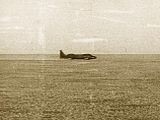 The Bluebird races across the salt flats of Lake Eyre.
The Bluebird races across the salt flats of Lake Eyre.
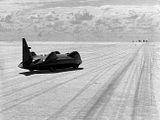 Campbell returns the Bluebird to the start after a trial run.
Campbell returns the Bluebird to the start after a trial run.
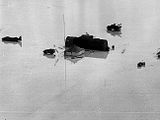 Campbell's camp at Lake Eyre.
Campbell's camp at Lake Eyre.
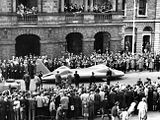 Campbell parades his car past crowds in front of Adelaide Town Hall. Picture: Advertiser Library.
Campbell parades his car past crowds in front of Adelaide Town Hall. Picture: Advertiser Library.
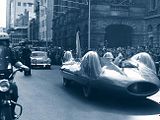 Campbell waves to fans on King William Street.
Campbell waves to fans on King William Street.
|
